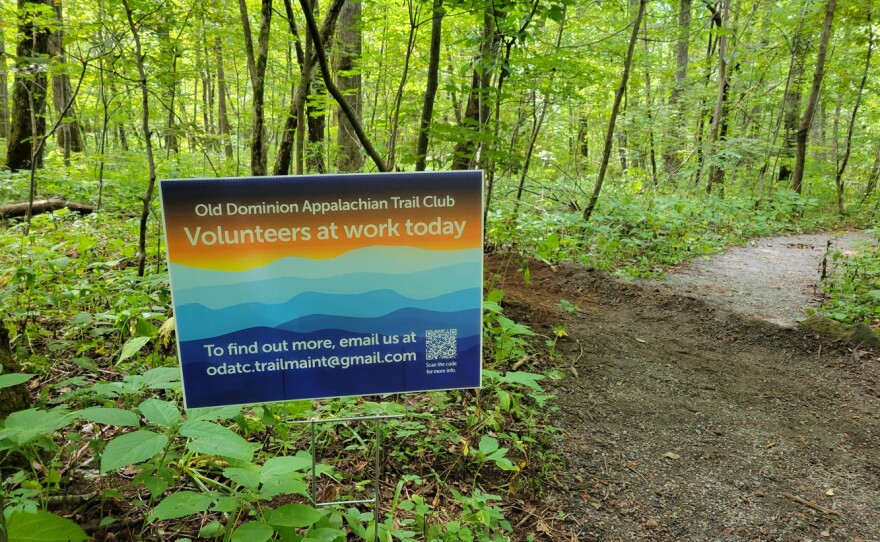Escapism has brought people to the Appalachian Trail for years, and over this past, pandemic-ridden year, more people than normal found themselves on the trail for that very reason. But that influx of people brings other issues - like littering - which is straining both the trail systems and the volunteers and professionals who maintain them.
Visitors to popular trails destinations such as Shenandoah National Park or Grayson Highlands State Park have increased through the pandemic. Kathryn Henderon-Powell, regional manager of the Central Virginia Appalachian Trail Conservancy, says estimates are based on the density of parking lots and voluntary sign-ins by visitors.
Sections of trail farther away from trailheads had fewer visitors, because they’re harder to reach and because many long-distance hikers postponed their trips after hearing about overcrowding.
Powell says people enjoying the trails can build community and connections.
“One wonderful thing about encountering other people on somewhere like the Appalachian Trail is you kind of have so much in common already when you meet on that shared ground because you wouldn’t be out there if you didn't love the resource, '' Powell said. “If you meet someone who doesn’t have the same background and politics, you already know you have something in common because you’re already out there.”
The sense of community is what attracts hikers to the Appalachian trail, but this community can be dismantled if the trail is not property taken off. Volunteer trail supervisors, like Mark Heede with the Old Dominion Appalachian Trail Club, perform some of that work.
“Principally, [our job] is to maintain the trail and the features of the trail,” Heede said.
Appalachian Trail volunteer clubs are assigned responsibilities through agreements with the trail conservatory and various federal parties such as the United States Forest Service and the National Parks Service.
Heede’s club goes out to the trails for a regular working trip once a month. In these trips, the group maintains the health and look of the trail by cutting back vegetation, removing fallen trees, building and maintaining trail shelters, clearing litter and installing drainage features.
The small group is responsible for 19.1 miles running from Reed’s Gap to Rockfish Gap. This work is already extensive for a small volunteer group, and becomes more tedious when more people use the trail. The pressure from increased foot traffic accelerates the erosion of the trail and its features.
“The Appalachian Trail is designed to provide a journey through a largely undisturbed, remote, natural setting with a simple narrow path,” Powell said. “So when we get a big influx of people all of sudden checking out a beautiful view they saw on Instagram, it can lead to a lot of trampling of the vegetation.”
When vegetation dies, the soil gets compacted. This is when erosion begins and roots and rocks are exposed.
In an attempt to lessen this problem, Heede recommends hikers avoid the popular mass start in Georgia every spring. Powell suggests weekend or day hikers discover less popular routes.
With the increase of travelers, litter and graffiti have increased, too. Graffiti places extra burdens on volunteer groups, and can be difficult to remove.
Not everyone who liters realizes they’re harming the trail, Powell says. Hikers sometimes throw food thought to be biodegradable in the forest, assuming it will compost: apple pits, orange and banana peels, etc.
She said, “One orange peel or apple core may not seem like a big deal, but when you magnify it by thousands of visitors every year, we can see some more important impacts escalating by then."
These items don’t break down as quickly as in a compost bin because of the forest’s dry environment. Having these items lay on the forest floor can signal a new food resource to animals and disrupt ecosystems and campsites.
Ultimately, education on how to interact with the trail is the best way to protect the trail. Hikers are encouraged to learn and understand leave no trace, a set of guidelines that aim to help people lower their impact on the environment. The guidelines help people prepare, remind them to be courteous of others, to dispose of waste properly and more.
And if people see problems on the trail, they can contact the volunteer group who maintains the area, for problems ranging from broken staircases, trampled vegetation or damaged shelters.
Powell also says she’d encourage more people to volunteer with trail groups, regardless of experience level.
“I would love it if folks would get more hands-on experiences even if it’s something they only do once,” Powell said. “It's a really rewarding type of volunteer project and then it’s also once you get a little taste of what it’s like, the next time you go hiking you have a better appreciation for the trail.”




